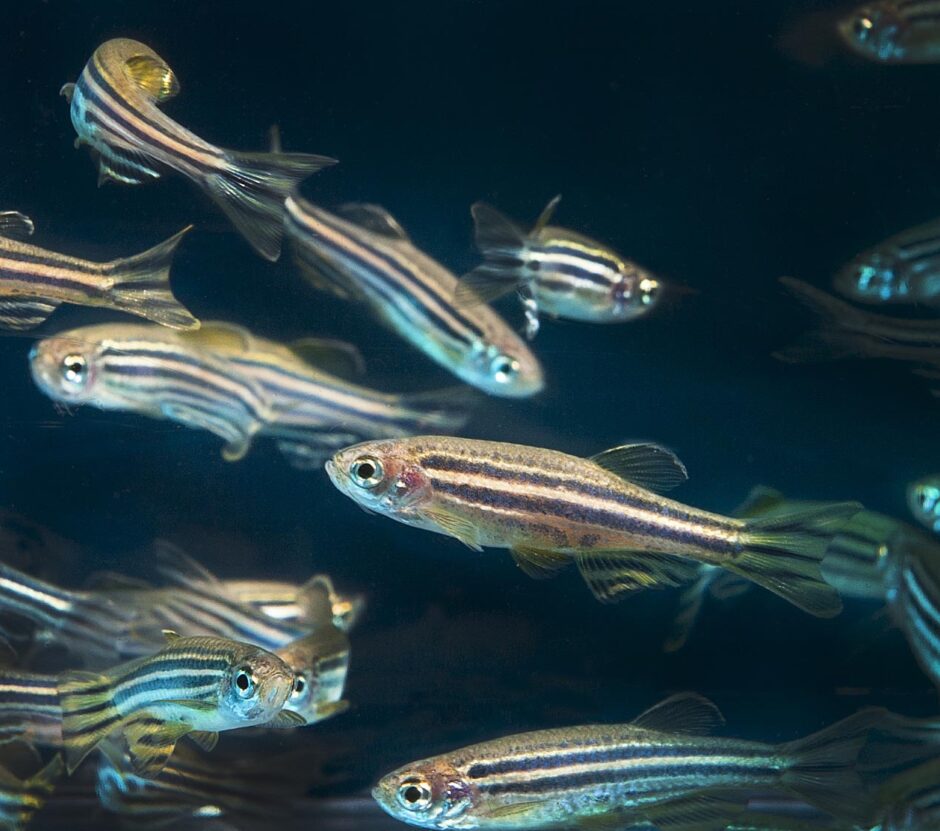How Atrazine Impacts Aquatic Systems
 Zebrafish are used in research at Oregon State University. (Credit: Lynn Ketchum, courtesy of Oregon State University via Flickr CC BY-SA)
Zebrafish are used in research at Oregon State University. (Credit: Lynn Ketchum, courtesy of Oregon State University via Flickr CC BY-SA)Atrazine is a chlorinated triazine systemic herbicide designed to control annual grasses and broadleaf weeds before they have a chance to emerge. According to the EPA, the use of the herbicide is restricted to certified users and registered for use on specific crops, most commonly on field corn, sweet corn, sorghum and sugarcane. Despite being frequently used and categorized as a Restricted Use Pesticide, atrazine is still a common contaminant in waterways bordering agricultural areas.
Environmental Impacts of Atrazine
A number of studies focusing on atrazine have charted the environmental impacts of the substance, including those laying out the effects it has on fish and other aquatic life. According to the National Pesticide Information Center, atrazine is broken down slowly by water, microorganisms and sunlight, with a half-life of 578 days in water and 168 days in water exposed to sunlight.
Atrazine also moves through soil easily, meaning that it has a high potential of reaching ground and surface waters. Once Atrazine reaches the water, it can pass through water treatment facilities and sometimes be found at low levels in community water systems. In freshwater rivers and streams, atrazine is considered slightly to moderately toxic to fish after four days or less of exposure.
The herbicide is highly toxic to freshwater invertebrates and very highly toxic to marine invertebrates. While these species may seem insignificant due to their size, these organisms are vital to the rest of the food web, supporting species that play different roles in the complex system. Atrazine is also known to be harmful to aquatic vegetation, which has dramatic impacts on systems for similar reasons.
A 2016 study from Purdue University assessed how exposure to atrazine affects the development of young female zebrafish. The fish are commonly used in studies as zebrafish serve as a model organism for humans.
In the study, the fish were exposed to atrazine during a 72-hour embryonic development time, which mirrors human prenatal development, to atrazine at levels of 0, 0.3, 3 or 30 parts per billion. When the fish reached maturity, researchers found that 5 percent of the female zebrafish exposed to 30 parts per billion of atrazine had swollen abdomens.

Effects of embryonic atrazine exposure on adult female zebrafish. (Credit: Wirbisky et al., 2016 / Purdue University
It appeared as if the female fish were egg-bound, a condition wherein eggs do not pass through normally as a result of there being no males to mate with. However, this condition should not have occurred as the female fish in this study were paired for breeding. The researchers also controlled for other pathogens or infections.
The fish with swollen abdomens also had an increase in atretic ovarian follicles. Other studies have shown that atrazine affects the LH gene, which produces the hormone that triggers ovulation and plays a key role in follicle development. Scientists say that a later-in-life effect of atrazine exposure could be due to that observed reduction in LH, which provides a mechanism behind the observed reduction in spawning, follicles and cystic ovarian degeneration.
While there were no major deformations in the fish, there were decreases in head length compared to body length at the highest dose of 30 parts per billion, scientists say. Even in the middle doses of 0.3 and 3 parts per billion, there was a significant increase in head width compared to total body length. Previous research shows that this deformation was reflected in offspring when exposed directly during the first 72 hours of life.
When the fish reached maturity, they were paired for breeding to assess the impacts of atrazine on reproduction. Compared to the control group, females exposed to 30 parts per billion were not successful at breeding, regardless of whether they appeared to be egg-bound or not. Fish that did successfully release eggs produced offspring that hatched and survived.
Conclusion
The results of the 2016 study were significant because it was the first study to expose female zebrafish to atrazine during their first 72 hours of life. Fish living in contaminated waterways are likely to be exposed in the early stages of their lives, something that was reflected in this study. By assessing the long-term impacts of atrazine exposure, scientists can better understand how the herbicide impacts aquatic life.
In particular, understanding how pesticides and herbicides like atrazine impact aquatic systems and species may be critical for species management. Species with low recruitment and spawn rates may be further threatened by deformities that impact their ability to reproduce, potentially setting the entire system off-balance.


Pingback: FishSens Magazine | Declining Mountain Streams Still Supporting Fish - FishSens Magazine